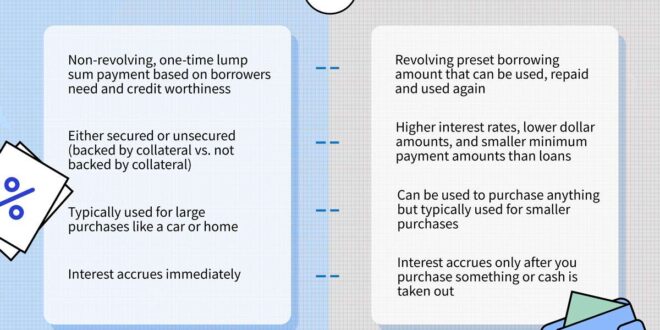A stated business line of credit can be a valuable tool for businesses seeking flexible financing. This type of credit line allows businesses to borrow money as needed, up to a predetermined limit, without having to go through a lengthy application process each time. While stated business lines of credit can offer several benefits, it’s crucial to understand their intricacies, including eligibility requirements, interest rates, and potential downsides.
This guide delves into the world of stated business lines of credit, providing insights into their workings, benefits, and drawbacks. We’ll explore the application process, discuss alternative financing options, and equip you with the knowledge to make informed decisions regarding this type of financing.
Understanding a Stated Business Line of Credit

A stated business line of credit is a financing option that allows businesses to access funds without having to provide extensive financial documentation. It is often referred to as a “no-doc” or “self-reported” line of credit.
This type of financing is particularly attractive to businesses that are new, have limited credit history, or prefer to avoid the hassle of providing detailed financial information.
Key Features and Characteristics
A stated business line of credit is characterized by a streamlined application process and minimal documentation requirements.
Here are some key features:
- Simplified Application Process: Stated lines of credit typically require less documentation than traditional lines of credit, making the application process faster and easier.
- Self-Reported Financial Information: Borrowers are typically asked to provide their own financial information, such as revenue and expenses, without the need for formal financial statements.
- Faster Approval Times: Due to the simplified application process, stated lines of credit often have faster approval times compared to traditional lines of credit.
- Higher Interest Rates: The convenience and reduced risk assessment come at a cost. Stated lines of credit typically have higher interest rates compared to traditional lines of credit.
- Lower Credit Limits: The lender’s reliance on self-reported information often results in lower credit limits compared to traditional lines of credit.
Comparison with Other Financing Options
Stated business lines of credit are often compared to other types of business financing, such as traditional lines of credit, merchant cash advances, and business loans.
- Traditional Lines of Credit: These require extensive financial documentation and credit history checks, resulting in longer approval times but potentially lower interest rates and higher credit limits.
- Merchant Cash Advances: These provide upfront funding in exchange for a percentage of future sales. They typically have high interest rates and may not be suitable for all businesses.
- Business Loans: These offer a fixed amount of funding with a set repayment schedule. They typically require a thorough credit history check and may have longer approval times compared to stated lines of credit.
Choosing the Right Financing Option
The best financing option for a business depends on its specific needs and circumstances. Stated business lines of credit can be a good option for businesses that need quick access to funds and are willing to accept higher interest rates. However, businesses with strong credit history and a need for larger amounts of funding may be better served by traditional lines of credit or business loans.
Eligibility and Requirements

Securing a stated business line of credit involves meeting specific criteria and providing essential documentation. This section delves into the typical eligibility requirements, documentation needed, and common credit score and financial history expectations.
Eligibility Criteria
Lenders generally consider various factors to determine eligibility for a stated business line of credit. These factors typically include:
- Business Type and Industry: Lenders often have preferences for certain industries and business models. For example, they might favor established businesses with a proven track record in low-risk industries.
- Business Age: A minimum business age is usually required, often ranging from one to two years. This requirement helps lenders assess the business’s stability and history.
- Revenue and Profitability: Lenders evaluate your business’s financial performance, including revenue and profitability, to assess its ability to repay the loan. They may look at financial statements like income statements and balance sheets.
- Credit History: Your personal credit score and business credit history are crucial factors. Lenders want to see a responsible credit history, indicating a history of timely payments and responsible borrowing.
- Debt-to-Equity Ratio: This ratio reflects the proportion of debt to equity in your business. Lenders prefer a lower debt-to-equity ratio, suggesting a healthier financial structure.
- Collateral: While not always required, some lenders may request collateral to secure the loan. This could be real estate, equipment, or inventory.
Documentation Requirements, Stated business line of credit
To apply for a stated business line of credit, you’ll typically need to provide the following documentation:
- Business Plan: This document Artikels your business’s goals, strategies, and financial projections. It helps lenders understand your vision and assess the viability of your business.
- Personal and Business Tax Returns: Lenders review these documents to verify your income and financial history. They may request several years of tax returns.
- Financial Statements: You’ll need to provide recent income statements, balance sheets, and cash flow statements to demonstrate your business’s financial performance.
- Bank Statements: Lenders may request bank statements to assess your cash flow and financial management practices.
- Credit Reports: You’ll need to provide both your personal and business credit reports to demonstrate your creditworthiness.
- Personal and Business Identification: This includes your driver’s license, Social Security number, and business registration documents.
Credit Score and Financial History Requirements
A strong credit score and positive financial history are essential for securing a stated business line of credit. Lenders typically prefer applicants with a good credit score, ideally above 680.
- Credit Score: A good credit score demonstrates your responsible borrowing history and increases your chances of approval. It also influences the interest rate you’ll receive.
- Financial History: Lenders evaluate your business’s financial history to assess its stability and ability to repay the loan. They look for consistent revenue, profitability, and a track record of timely payments.
- Debt-to-Income Ratio: This ratio indicates the proportion of your income used to pay off existing debt. Lenders prefer a lower debt-to-income ratio, showing you have sufficient income to manage your existing obligations and make payments on the new loan.
Closure

In conclusion, stated business lines of credit can be a viable financing option for businesses seeking quick access to capital. However, careful consideration of eligibility criteria, interest rates, and potential risks is essential. By understanding the intricacies of this financing method, businesses can make informed decisions that align with their financial goals and overall business strategy.
Commonly Asked Questions
What is the difference between a stated business line of credit and a traditional business line of credit?
A stated business line of credit typically requires less documentation and a less rigorous review process than a traditional business line of credit. It often relies on the business owner’s stated income rather than extensive financial statements. However, this may result in higher interest rates.
How do I know if a stated business line of credit is right for my business?
Consider your business’s financial health, credit history, and immediate funding needs. A stated business line of credit might be suitable if you have a good credit score, require quick access to capital, and are comfortable with potentially higher interest rates.
What are some examples of how a stated business line of credit can be used?
Businesses can use a stated business line of credit for various purposes, including covering seasonal cash flow needs, purchasing inventory, financing marketing campaigns, or covering unexpected expenses.
 Norfolk Publications Publications ORG in Norfolk!
Norfolk Publications Publications ORG in Norfolk!

